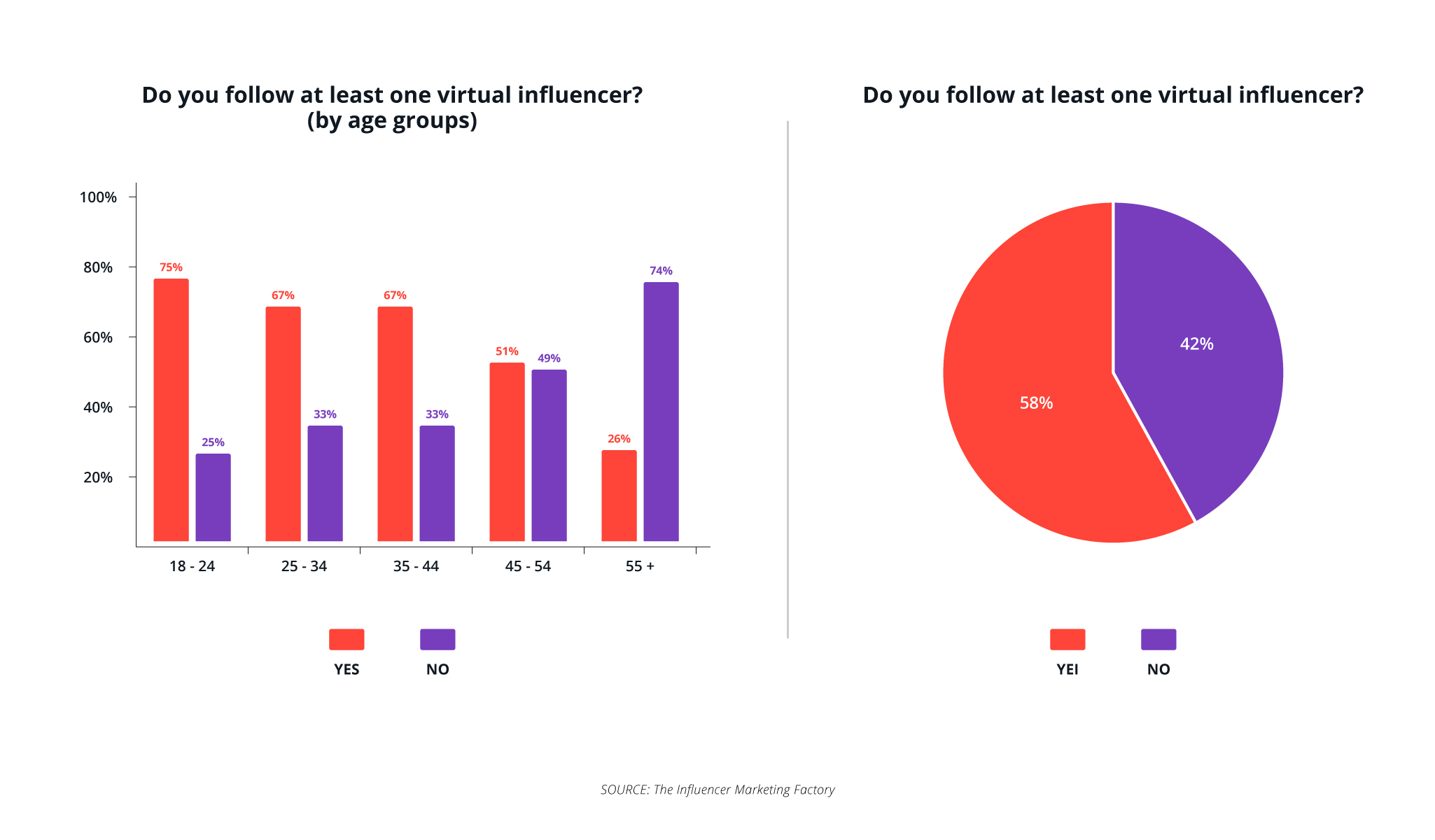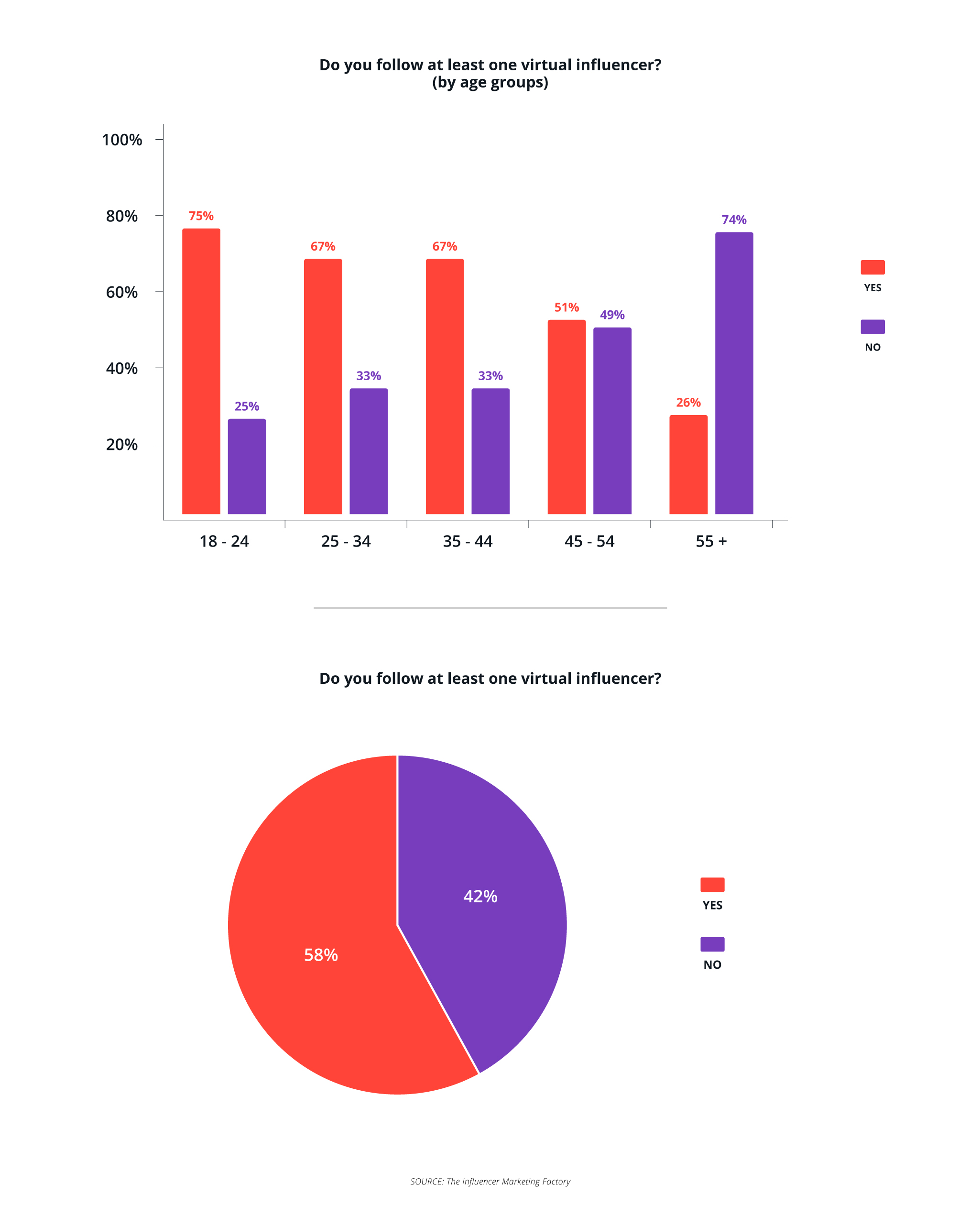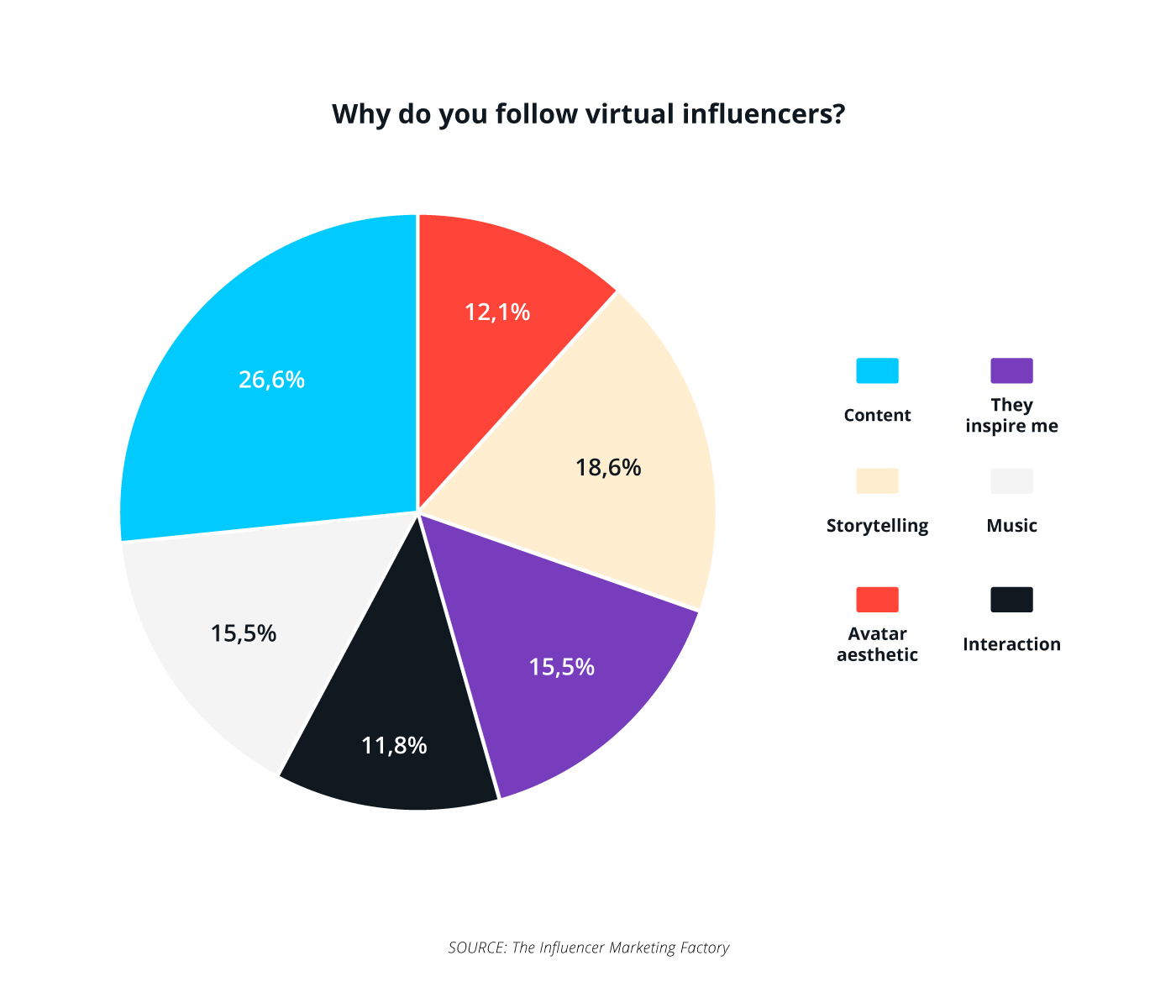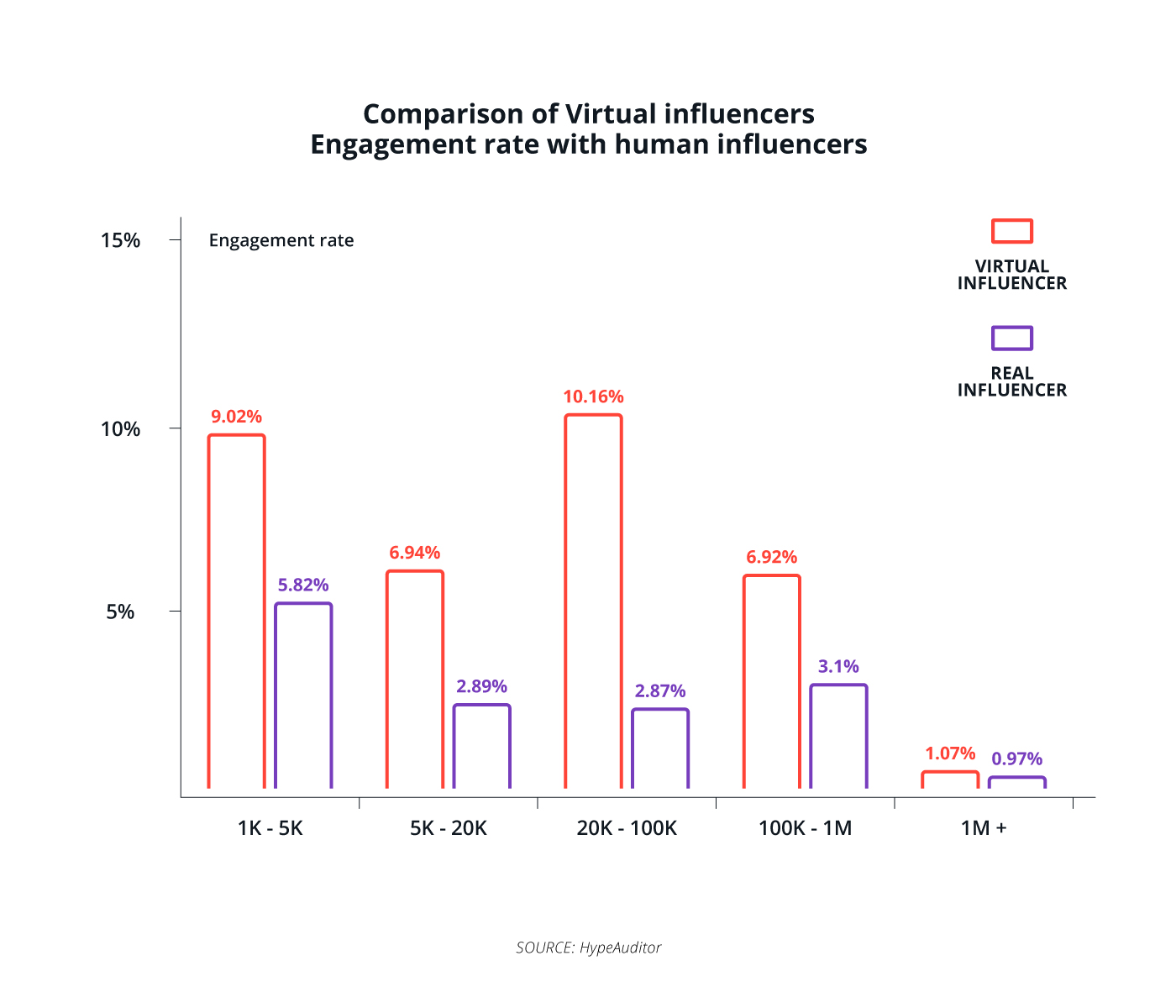Virtual influencer: new frontier of the digital world
What are the reasons why brands are already preferring or placing them alongside human ones?
For a few years now, integrating influencer marketing activities within multi-channel brand strategies has been a fundamental action to reach target groups that are more wary of brand communication: an example of this are the young people of Gen Z, whose characteristics, behaviour and habits we have analysed as OpenKnowledge within the Zeneration Time insert, available here.
By targeting emerging digital touchpoints and exploiting their potential to spread through influencer marketing campaigns, it is possible not only to broaden the pool of users addressed, but also to strengthen the relationship with the community, thus creating more trust in the brand.
But what (or who) are we talking about?
n an ever-evolving context, one of the emerging trends concerns the success of virtual influencers, i.e. virtual avatars, generated through artificial intelligence systems, designed and created with physical and behavioural characteristics similar to those of human influencers.
Created through CGI (Computer-Generated Imagery) technology, virtual influencers originated in Asia, where they are so popular that artificial intelligence creations have generated a market estimated by Statista at almost USD 14 billion in the year 2021.
What do they tell their audience?
The actions that virtual influencers perform are very similar to those of real-life influencers. For example:
- have a distinct style and personality that sets them apart;
- are part of a social and relational ecosystem, being able to develop friendships, romantic relationships, sympathies but also deep incompatibilities and aversions between them;
- they speak out on topics of interest, current affairs, trying to raise awareness among their target fanbase, which otherwise would risk being potentially left out.
- promote social dynamics of public interest through the dissemination of CSR strategies implemented by the companies they support and sponsor;
- They sponsor brands and products with ad hoc content.
- share everyday moments, hobbies, interests, passions and free time;
Who do they address?
As we have anticipated, the emergence of virtual influencers, or Computer-Generated Imagery Influencers, stems mainly from the social, cultural and psychological changes that have occurred in recent years, especially with the advent of the pandemic. These changes have profoundly affected the behaviour and habits of the new generations, especially Gen Z.
The ad-hoc contents proposed by virtual influencers somehow represent habits, experiences and lifestyles that most of Generation Z would like to make their own
Why do they communicate effectively?
Thanks to their speed of publication on social networks and their ubiquity, virtual influencers are able to limit this pervasive problem by building trusting and stable relationships with their followers and thus act as facilitators of conversations for their target audience, who now relate almost exclusively through the use of social channels.
In recent years, there has been a change in users’ attitudes towards virtual influencers, especially on the part of those who are already accustomed to interacting with avatars, think for instance of the young gamers who use them to explore the digital worlds of videogames, but not only that, the very spread of the metaverse is making immersive virtual experiences more and more ‘real’ and widespread.
A recent study of American consumers found that:
- 58% follow at least one virtual influencer;
- 24% of those who do not follow them, do not know them;
- 27% follow virtual influencers for their content, 19% for storytelling and 15% because they are inspired by them;
- Users aged 25-44 are those who trust virtual influencers the most when recommending a product;
- 35% bought a product promoted by a virtual influencer.


The same analysis also explores the motivations that lead users to follow virtual influencers:
- the majority (26.6%) said they follow them for their content;
- secondly, survey participants stated that they follow virtual influencers for their storytelling (18.6%)
- tied for third place was because they inspire them (15.5%) and because of their musical tastes (15.5%),
- in fourth place follows the style and aesthetics of the avatar (12.1%)
- fifth and last place was interaction (11.8%).

The percentages just reported corroborate the thesis according to Hype’s latest 2020 report, it was shown that the engagement rate of a virtual influencer is three times higher than that of their human counterparts, with a target audience consisting mainly of girls from the Y and Z generations.

But what are the reasons why a brand prefers Virtual Influencers to real ones? What is the added value of using digital figures?
The phenomenon of virtual influencers, precisely because they are particularly effective for the target group just analysed, is characterised by widespread use by brands. Thanks to their human-like nature that allows them to inspire and influence the fanbase that follows them, they become strategic assets in the hands of brands, which use them for their own marketing campaigns.
Through the grounding of such a digital strategy, brands have the opportunity to develop and convey content that is perfectly in line with the company’s essence and values, as well as exactly in target with the fanbase they are addressing.
Another aspect to be taken into account is the transmedia aspect: virtual influencers are simultaneously present on several platforms and not only on Instagram, which still remains the main channel, thus managing to maintain a consistency of content publication and reaching a large audience.
Virtual influencers, being tailor-made figures for companies, are able to maintain a high brand reputation and foster effective and direct brand communication, without making social gaffes that could damage the image of the brand they sponsor.
In addition, ‘avatarised’ influencers are characterised by greater versatility than their flesh-and-blood counterparts, as they are characters that can transcend the boundaries of concrete reality.
Among the most frequent criticisms levelled at avatars is, of course, the inability to conceive as real something that is not real. Within the social world, however, between filters and avatars, the boundary between the two dimensions is drastically flattened, leading reality and the virtual world to mix.
The approach to social issues, however, breaks down the barrier between real and virtual and brings the world of virtual influencer marketing to be as credible as the physical one. There are many social accounts that address issues of this kind: one of them is that of Miquela Sousa, the most famous and followed virtual influencer on the web (3 million followers on Instagram alone), who has carried out campaigns in support of social issues such as ‘Black Lives Matter’, managing to collect donations from her followers, obtaining many positive comments and feedback from them.
The following of @lilmiquela, the young 19-year-old musician living in Los Angeles of Spanish and Brazilian origin, is so high that the most international fashion and luxury brands such as Prada, Gucci, Chanel, Diesel or Calvin Klein have decided to invest in virtual influencer marketing, opening collaborations. Although an avatar, Miquela is perceived by her followers as a real person who likes to have fun and spend free time with her friends (who are also virtual influencers), who loves fashion and make-up and who also had, like any other human being, a boyfriend @nicklilian, whose relationship, however, seems to have ended, showing all her fragilities and insecurities of a girl of her age.
Therefore, as social profiles are created ad hoc, they allow them to adapt not only to current issues by showing their closeness to the community, breaking down ‘social walls’ related to prejudice or diversity, but also to the company’s dynamics and to evolve together with the company’s brand identity and values. Indeed, Miquela’s profile in this sense is evident: in addition to the many collaborations with luxury brands, partnerships with tech brands are also evident on its social profiles. An example can be seen in the Instagram, #DoWhatYouCant campaign that Samsung did with the virtual influencer in July 2019, choosing her to represent its #TeamGalaxy.
Conclusions.
The distinction between real and virtual reality, however, exists in the minds of users, who, after an initial moment of emphasis on contact with avatars, come to realise that the dialogue and interaction is with a non-real creator. The risk, therefore, that the emotional component that characterises real relationships remains high, leading to a loss of trust that can be fatal to brand reputation.
This is why, despite the enormous potential and undoubted communication skills, to make the most of a virtual influencer it is not enough to have excellent technological and 3D design skills alone, but it is necessary to develop and devise a strategy based on creative formats and editorial content in line with the company’s needs and following a storytelling and communication coherence across all digital touchpoints.
Author
Tania Tornese

 26 October 2022
26 October 2022
